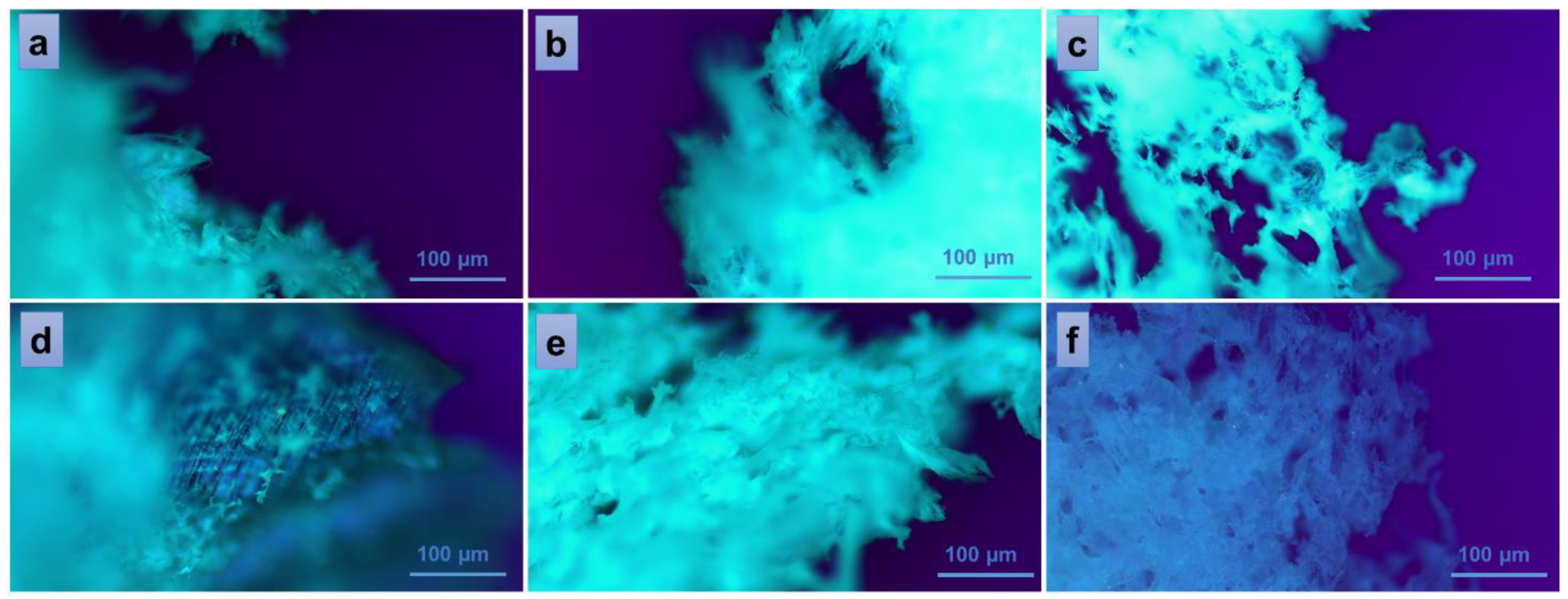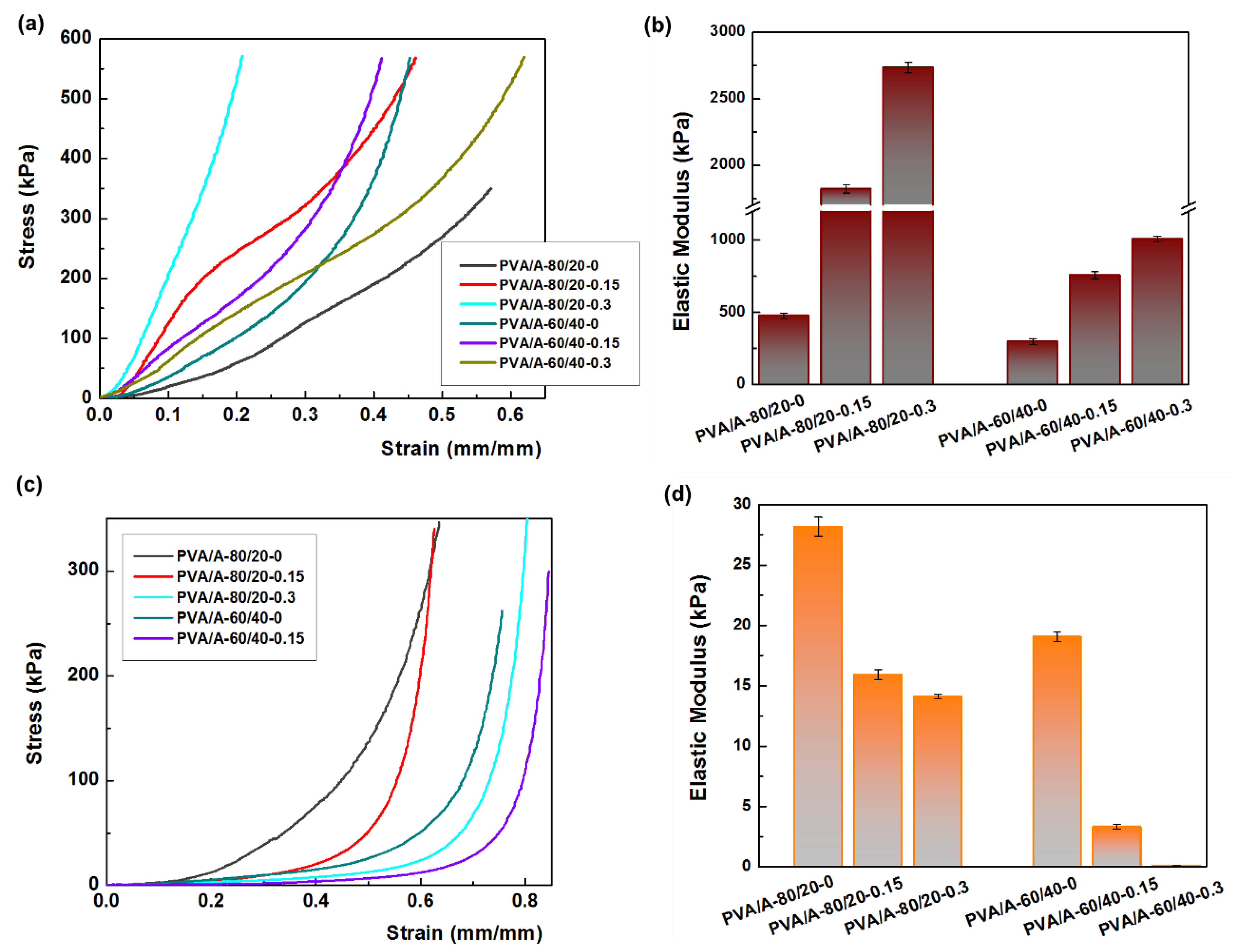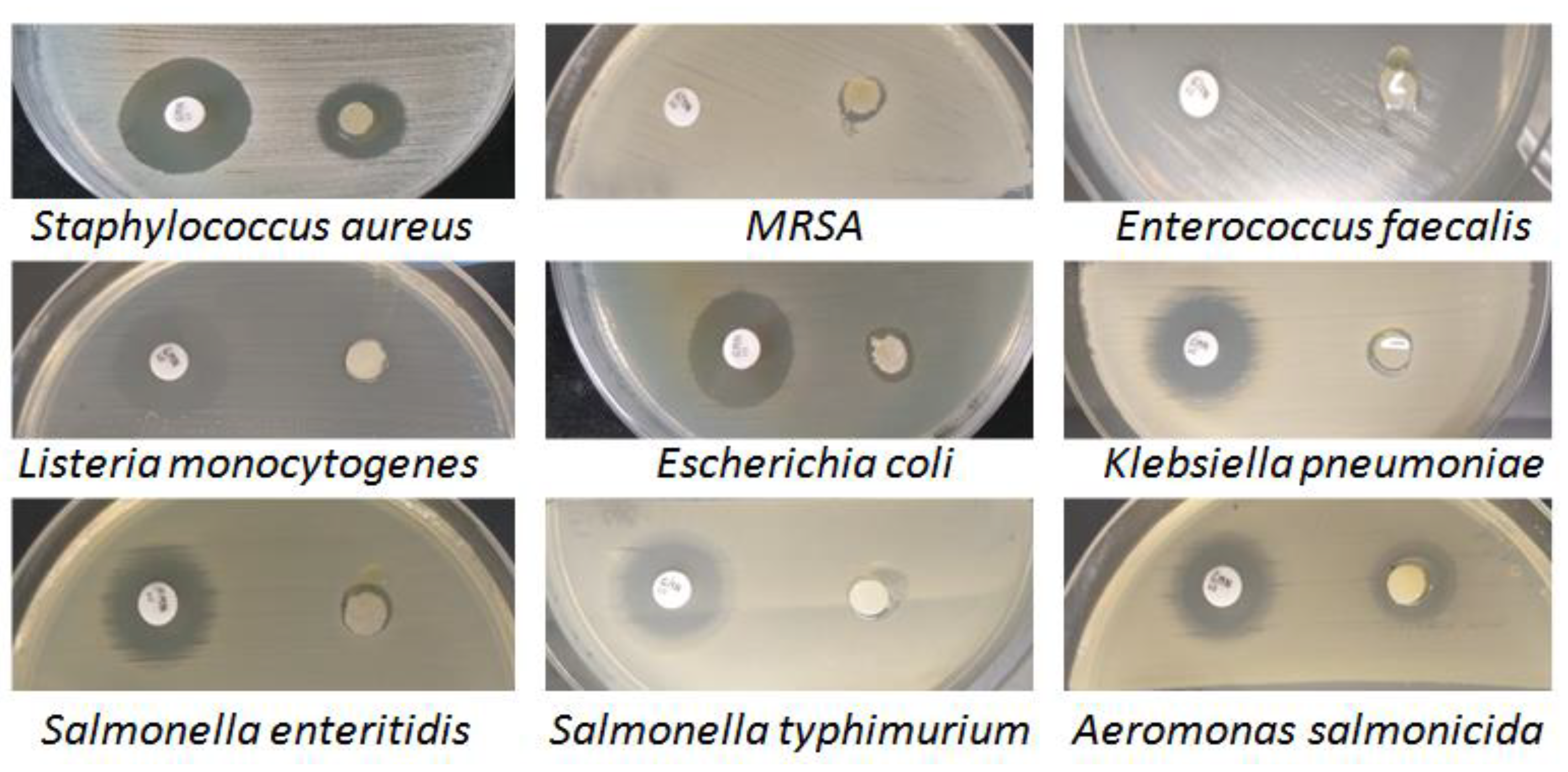Antimicrobial Activity of Artemisia dracunculus Oil-Loaded Agarose/Poly(Vinyl Alcohol) Hydrogel for Bio-Applications
Abstract
:1. Introduction
2. Results and Discussion
2.1. Preparation, Synthesis, and Structural Characterization of Artemisia dracunculus Essential Oil
2.2. Preparation, Synthesis, and Structural Characterization of PVA/A Hydrogel Matrix and PVA/A Hydrogel Matrix Loaded with Artemisia dracunculus Essential Oil
2.3. Mechanical Behavior
2.4. In Vitro Evaluation of the Antimicrobial Potential of Essential Oil Artemisia dracunculus Essential Oil
2.5. In Vitro Evaluation of the Antimicrobial Potential of PVA/A Hydrogel and PVA/A Loaded with Artemisia dracunculus Essential Oil Hydrogel
3. Conclusions
4. Materials and Methods
4.1. Materials
4.2. Methods
4.2.1. FTIR Investigation
4.2.2. 1H NMR Investigation
4.2.3. UV-VIS Investigation
4.2.4. GC-MS Analysis
4.2.5. Scanning Electron Microscopy Investigation
4.2.6. Polarized Optical Microscopy
4.2.7. Mechanical Properties of the PVA/A Hydrogels
4.2.8. Preparation of the Hydrogels
4.2.9. Preparation of the PVA/A Loaded with Artemisia dracunculus Essential Oil Hydrogels
4.2.10. Antimicrobial Activity
Bacterial Strains
Antimicrobial Susceptibility Testing Using the Diffusion Method
Antimicrobial Susceptibility Testing by Time-Kill Assay
Supplementary Materials
Author Contributions
Funding
Institutional Review Board Statement
Informed Consent Statement
Data Availability Statement
Acknowledgments
Conflicts of Interest
References
- Eisenman, S.W.; Struwe, L. The global distribution of wild tarragon (Artemisia dracunculus L.; Asteraceae) cytotypes with twenty-seven new records from North America. Genet. Resour. Crop. Evol. 2011, 58, 1199–1212. [Google Scholar] [CrossRef]
- Ekiert, H.; Klimek-Szczykutowicz, M.; Rzepiela, A.; Klin, P.; Szopa, A. Artemisia Species with High Biological Values as a Potential Source of Medicinal and Cosmetic Raw Materials. Molecules 2022, 27, 6427. [Google Scholar] [CrossRef] [PubMed]
- Ekiert, H.; Świątkowska, J.; Knut, E.; Klin, P.; Rzepiela, A.; Tomczyk, M.; Szopa, A. Artemisia dracunculus (Tarragon): A Review of Its Traditional Uses, Phytochemistry and Pharmacology. Front. Pharmacol. 2021, 12, 653993. [Google Scholar] [CrossRef]
- Aglarova, A.M.; Zilfikarov, I.N.; Severtseva, O.V. Biological characteristics and useful properties of tarragon (Artemisia dracunculus L.). Pharm. Chem. J. 2008, 42, 81–86. [Google Scholar] [CrossRef]
- Majdan, M.; Kiss, A.K.; Hałasa, R.; Granica, S.; Osińska, E.; Czerwińska, M.E. Inhibition of Neutrophil Functions and Antibacterial Effects of Tarragon (Artemisia dracunculus L.) Infusion—Phytochemical Characterization. Front. Pharmacol. 2020, 11, 947. [Google Scholar] [CrossRef] [PubMed]
- Obolskiy, D.; Pischel, I.; Feistel, B.; Glotov, N.; Heinrich, M. Artemisia dracunculus L. (Tarragon): A Critical Review of Its Traditional Use, Chemical Composition, Pharmacology, and Safety. J. Agric. Food Chem. 2011, 59, 11367–11384. [Google Scholar] [CrossRef]
- Eidi, A.; Oryan, S.; Zaringhalam, J.; Rad, M. Antinociceptive and anti-inflammatory effects of the aerial parts of Artemisia dracunculus in mice. Pharm. Biol. 2016, 54, 549–554. [Google Scholar] [CrossRef]
- Maham, M.; Moslemzadeh, H.; Jalilzadeh-Amin, G. Antinociceptive effect of the essential oil of tarragon (Artemisia dracunculus). Pharm. Biol. 2013, 52, 208–212. [Google Scholar] [CrossRef]
- Méndez-del Villar, M.; Puebla-Pérez, A.M.; Sánchez-Peña, M.J.; González-Ortiz, L.J.; Martínez-Abundis, E.; González-Ortiz, M. Effect of Artemisia dracunculus Administration on Glycemic Control, Insulin Sensitivity, and Insulin Secretion in Patients with Impaired Glucose Tolerance. J. Med. Food 2016, 19, 481–485. [Google Scholar] [CrossRef]
- Shahriyary, L.; Yazdanparast, R. Inhibition of blood platelet adhesion, aggregation and secretion by Artemisia dracunculus leaves extracts. J. Ethnopharmacol. 2007, 114, 194–198. [Google Scholar] [CrossRef]
- Ayşe, K.; Çağlak, E. Phytochemical Research and Evaluation of Tarragon (Artemisia dracunculus L.) as a Food Additive. Recep Tayyip Erdoğan Üniversitesi Fen Mühendislik Bilim. Derg. 2022, 3, 50–60. [Google Scholar]
- Kheterpal, I.; Coleman, L.; Ku, G.; Wang, Z.Q.; Ribnicky, D.; Cefalu, W.T. Regulation of insulin action by an extract of Artemisia dracunculus L. in primary human skeletal muscle culture: A proteomics approach. Phytother. Res. 2010, 24, 1278–1284. [Google Scholar] [CrossRef] [PubMed]
- Lopes-Lutz, D.; Alviano, D.S.; Alviano, C.S.; Kolodziejczyk, P.P. Screening of chemical composition, antimicrobial and antioxidant activities of Artemisia essential oils. Phytochemistry 2008, 69, 1732–1738. [Google Scholar] [CrossRef] [PubMed]
- Chaleshtori, R.S.; Rokni, N.; Razavilar, V.; Kopaei, M.R. The Evaluation of the Antibacterial and Antioxidant Activity of Tarragon (Artemisia dracunculus L.) Essential Oil and Its Chemical Composition. Jundishapur J. Microbiol. 2013, 6, e7877. [Google Scholar] [CrossRef]
- Zarezade, V.; Moludi, J.; Mostafazadeh, M.; Mohammadi, M.; Veisi, A. Antioxidant and hepatoprotective effects of Artemisia dracunculus against CCl4-induced hepatotoxicity in rats. Avicenna J. Phytomed. 2018, 8, 51–62. [Google Scholar] [PubMed]
- Mamedov, N.; Gardner, Z.; Craker, L.E. Medicinal Plants Used in Russia and Central Asia for the Treatment of Selected Skin Conditions. J. Herbs, Spices Med. Plants 2005, 11, 191–222. [Google Scholar] [CrossRef]
- Safari, H.; Sarab, G.A.; Naseri, M. Artemisia dracunculus L. modulates the immune system in a multiple sclerosis mouse model. Nutr. Neurosci. 2019, 24, 843–849. [Google Scholar] [CrossRef] [PubMed]
- Mohammadi, M.M.; Saeb, M.; Nazifi, S. Experimental hypothyroidism in adult male rats: The effects of Artemisia dracunculus aqueous extract on serum thyroid hormones, lipid profile, leptin, adiponectin, and antioxidant factors. Comp. Clin. Pathol. 2019, 29, 485–494. [Google Scholar] [CrossRef]
- Efferth, T. Artemisinin–second career as anticancer drug? World J. Tradit. Chin. Med. 2015, 1, 2–25. [Google Scholar] [CrossRef]
- Navarro-Salcedo, M.H.; Delgado-Saucedo, J.I.; Siordia-Sánchez, V.H.; González-Ortiz, L.J.; Castillo-Herrera, G.A.; Puebla-Pérez, A.M. Artemisia dracunculus Extracts Obtained by Organic Solvents and Supercritical CO2 Produce Cytotoxic and Antitumor Effects in Mice with L5178Y Lymphoma. J. Med. Food 2017, 20, 1076–1082. [Google Scholar] [CrossRef]
- Trifan, A.; Zengin, G.; Sinan, K.I.; Sieniawska, E.; Sawicki, R.; Maciejewska-Turska, M.; Skalikca-Woźniak, K.; Luca, S.V. Unveiling the Phytochemical Profile and Biological Potential of Five Artemisia Species. Antioxidants 2022, 11, 1017. [Google Scholar] [CrossRef] [PubMed]
- Taleghani, A.; Emami, S.A.; Tayarani-Najaran, Z. Artemisia: A promising plant for the treatment of cancer. Bioorganic Med. Chem. 2019, 28, 115180. [Google Scholar] [CrossRef] [PubMed]
- Numonov, S.; Sharopov, F.; Salimov, A.; Sukhrobov, P.; Atolikshoeva, S.; Safarzoda, R.; Habasi, M.; Aisa, H.A. Assessment of Artemisinin Contents in Selected Artemisia Species from Tajikistan (Central Asia). Medicines 2019, 6, 23. [Google Scholar] [CrossRef] [PubMed]
- Guo, Z. Artemisinin anti-malarial drugs in China. Acta Pharm. Sin. B 2016, 6, 115–124. [Google Scholar] [CrossRef] [PubMed]
- Kordali, S.; Kotan, R.; Mavi, A.; Cakir, A.; Ala, A.; Yildirim, A. Determination of the chemical composition and antioxidant activity of the essential oil of Artemisia dracunculus and of the antifungal and antibacterial activities of Turkish Artemisia absinthium, A. dracunculus, Artemisia santonicum, and Artemisia spicigera essential oils. J. Agric. Food Chem. 2005, 53, 9452–9458. [Google Scholar]
- Liu, T.; Lin, P.; Bao, T.; Ding, Y.; Lha, Q.; Nan, P.; Huang, Y.; Gu, Z.; Zhong, Y. Essential oil composition and antimicrobial activity of Artemisia dracunculus L. var. qinghaiensis Y. R. Ling (Asteraceae) from Qinghai-Tibet Plateau. Ind. Crop. Prod. 2018, 125, 1–4. [Google Scholar] [CrossRef]
- Miyata, T.; Uragami, T.; Nakamae, K. Biomolecule-sensitive hydrogels. Adv. Drug Deliv. Rev. 2002, 54, 79–98. [Google Scholar] [CrossRef]
- Serbezeanu, D.; Iftime, M.M.; Ailiesei, G.-L.; Ipate, A.-M.; Bargan, A.; Vlad-Bubulac, T.; Rîmbu, C.M. Evaluation of Poly(vinyl alcohol)–Xanthan Gum Hydrogels Loaded with Neomycin Sulfate as Systems for Drug Delivery. Gels 2023, 9, 655. [Google Scholar] [CrossRef]
- Neculai-Valeanu, A.S.; Ariton, A.M.; Mădescu, B.M.; Rîmbu, C.M.; Creangă, Ş. Nanomaterials and Essential Oils as Candidates for Developing Novel Treatment Options for Bovine Mastitis. Animals 2021, 11, 1625. [Google Scholar] [CrossRef]
- Pelin, I.M.; Silion, M.; Popescu, I.; Rîmbu, C.M.; Fundueanu, G.; Constantin, M. Pullulan/Poly(vinyl alcohol) Hydrogels Loaded with Calendula officinalis Extract: Design and In Vitro Evaluation for Wound Healing Applications. Pharmaceutics 2023, 15, 1674. [Google Scholar] [CrossRef]
- Kobayashi, S.; Müllen, K. Encyclopedia of Polymeric Nanomaterials; Springer: Berlin/Heidelberg, Germany, 2015. [Google Scholar]
- Li, Y.; Chen, J.; Xue, M.; Ning, L.; Meng, A.; Liu, J. A comparative study on cytocompatibility of medical PVA and intelligent PVA-g-NIPAAm hydrogels. J. Biomed. Eng. Shengwu Yixue Gongchengxue Zazhi 1999, 16, 5–9. [Google Scholar]
- Dorkhani, E.; Faryabi, A.; Noorafkan, Y.; Heirani, A.; Behboudi, B.; Fazeli, M.S.; Kazemeini, A.; Keramati, M.R.; Keshvari, A.; Tafti, S.M.A. Biomedical properties and hemostatic efficacy of polyvinyl alcohol (PVA) based hydrogel in experimental rat liver injury model. J. Appl. Biomater. Funct. Mater. 2023, 21, 22808000231198803. [Google Scholar] [CrossRef] [PubMed]
- Barbato, A.; Apicella, A.; Malvano, F.; Scarfato, P.; Incarnato, L. High-Barrier, Biodegradable Films with Polyvinyl Alcohol/Polylactic Acid + Wax Double Coatings: Influence of Relative Humidity on Transport Properties and Suitability for Modified Atmosphere Packaging Applications. Polymers 2023, 15, 4002. [Google Scholar] [CrossRef] [PubMed]
- Enache, A.A.; Serbezeanu, D.; Vlad-Bubulac, T.; Ipate, A.M.; Suflet, D.M.; Drobotă, M.; Barbălată-Mândru, M.; Udrea, R.M.; Rîmbu, C.M. Tunable properties via composition modulations of poly (vinyl alcohol)/xanthan gum/oxalic acid hydrogels. Materials 2022, 15, 2657. [Google Scholar] [CrossRef] [PubMed]
- Doan, H.V.; Hoseinifar, S.H.; Esteban, M.Á.; Dadar, M.; Thu, T.T.N. Chapter 2-Mushrooms, Seaweed, and Their Derivatives as Functional Feed Additives for Aquaculture: An Updated View. Stud. Nat. Prod. Chem. 2019, 62, 41–90. [Google Scholar]
- Zhou, C.; Yu, X.; Zhang, Y.; He, R.; Ma, H. Ultrasonic degradation, purification and analysis of structure and antioxidant activity of polysaccharide from Porphyra yezoensis Udea. Carbohydr. Polym. 2012, 87, 2046–2051. [Google Scholar] [CrossRef]
- Gu, Y.; Cheong, K.-L.; Du, H. Modification and comparison of three Gracilaria spp. agarose with methylation for promotion of its gelling properties. Chem. Central J. 2017, 11, 104. [Google Scholar] [CrossRef] [PubMed]
- Bhar, A.; Das, S. The Advancement of Plant-Based Biopolymer Development for Films and Coatings: Possibilities and Challenges; Elsevier Inc.: Amsterdam, The Netherlands, 2023; ISBN 978-0-12-803581-8. [Google Scholar]
- Nasrollahzadeh, M.; Shafiei, N.; Nezafat, Z. Biopolymer-Based Metal Nanoparticle Chemistry for Sustainable Applications: Volume 1: Classification, Properties and Synthesis, cap. Synthesis of Biopolymer-Based Metal Nanoparticles, 1st ed.; Elsevier: Amsterdam, The Netherlands, 2021; pp. 255–316. ISBN 978-0-12-822108-2. [Google Scholar]
- Guedes, A.C.; Amaro, H.M.; Sousa-Pinto, I.; Malcata, F.X. Chapter 16-Algal spent biomass—A pool of applications. In Biofuels from Algae, 2nd ed.; Pandey, A., Chang, J.S., Soccol, C.R., Lee, D.J., Chisti, Y., Eds.; Elsevier: Amsterdam, The Netherlands, 2019; pp. 397–433. Available online: https://www.sciencedirect.com/science/article/pii/B9780444641922000160 (accessed on 11 December 2023).
- Song, E.H.; Shang, J.; Ratner, D.M. Polysaccharides. Polym. Sci. A Compr. Ref. 2012, 9, 137–155. [Google Scholar]
- Yun, E.J.; Choi, I.-G.; Kim, K.H. Red macroalgae as a sustainable resource for bio-based products. Trends Biotechnol. 2015, 33, 247–249. [Google Scholar] [CrossRef]
- Samadi, N.; Sabzi, M.; Babaahmadi, M. Self-healing and tough hydrogels with physically cross-linked triple networks based on Agar/PVA/Graphene. Int. J. Biol. Macromol. 2017, 107, 2291–2297. [Google Scholar] [CrossRef]
- Sun, X.; Luo, C.; Luo, F. Preparation and properties of self-healable and conductive PVA-agar hydrogel with ultra-high mechanical strength. Eur. Polym. J. 2020, 124, 109465. [Google Scholar] [CrossRef]
- Cheng, C.; Peng, X.; Xi, L.; Wan, C.; Shi, S.; Wang, Y.; Yu, X. An agar–polyvinyl alcohol hydrogel loaded with tannic acid with efficient hemostatic and antibacterial capacity for wound dressing. Food Funct. 2022, 13, 9622–9634. [Google Scholar] [CrossRef] [PubMed]
- Schulz, H.; Baranska, M. Identification and quantification of valuable plant substances by IR and Raman spectroscopy. Vib. Spectrosc. 2007, 43, 13–25. [Google Scholar] [CrossRef]
- Sisa, M.; Bonnet, S.L.; Ferreira, D.; Van der Westhuizen, J.H. Photochemistry of Flavonoids. Molecules 2010, 15, 5196–5245. [Google Scholar] [CrossRef] [PubMed]
- Suflet, D.M.; Pelin, I.M.; Dinu, V.M.; Lupu, M.; Popescu, I. hydrogels based on monobasic curdlan phosphate for biomedical applications. Cellul. Chem. Technol. 2019, 53, 897–907. [Google Scholar] [CrossRef]
- Lyons, J.G.; Geever, L.M.; Nugent, M.J.; Kennedy, J.E.; Higginbotham, C.L. Development and characterisation of an agar–polyvinyl alcohol blend hydrogel. J. Mech. Behav. Biomed. Mater. 2008, 2, 485–493. [Google Scholar] [CrossRef] [PubMed]
- UCAST. Aminoglycoside In Vitro Susceptibility Test Interpretation Criteria Evaluations. Version 1.3. 2019. Available online: https://app.box.com/s/un3r9bjyulkecbeu3uji34i5c9mbkii7 (accessed on 6 December 2023).
- Chaves, B.J.T.P. Gentamicin; StatPearls: Treasure Island, FL, USA, 2023. Available online: https://www.ncbi.nlm.nih.gov/books/NBK557550/ (accessed on 11 December 2023).
- Nazzaro, F.; Fratianni, F.; De Martino, L.; Coppola, R.; De Feo, V. Effect of Essential Oils on Pathogenic Bacteria. Pharmaceuticals 2013, 6, 1451–1474. [Google Scholar] [CrossRef]
- Mrabti, H.N.; El Hachlafi, N.; Al-Mijalli, S.H.; Jeddi, M.; Elbouzidi, A.; Abdallah, E.M.; Flouchi, R.; Assaggaf, H.; Qasem, A.; Zengin, G.; et al. Phytochemical profile, assessment of antimicrobial and antioxidant properties of essential oils of Artemisia herba-alba Asso., and Artemisia dracunculus L.: Experimental and computational approaches. J. Mol. Struct. 2023, 1294, 136479. [Google Scholar] [CrossRef]
- Umam, K.; Feng, C.S.; Yang, G.; Tu, P.C.; Lin, C.Y.; Yang, M.T.; Kuo, T.-F.; Yang, W.-C.; Tran Nguyen Minh, H. Phytochemistry, Pharmacology and Mode of Action of the Anti-Bacterial Artemisia Plants. Bioengineering 2023, 10, 633. [Google Scholar] [CrossRef]
- Swamy, M.K.; Akhtar, M.S.; Sinniah, U.R. Antimicrobial properties of plant essential oils against human pathogens and their mode of action: An updated review. Evid. Based Complement. Altern. Med. 2016, 2016, 3012462. [Google Scholar] [CrossRef]
- Aelenei, P.; Rimbu, C.M.; Horhogea, C.E.; Lobiuc, A.; Neagu, A.-N.; Dunca, S.I.; Motrescu, I.; Dimitriu, G.; Aprotosoaie, A.C.; Miron, A. Prenylated Phenolics as Promising Candidates for Combination Antibacterial Therapy: Morusin and Kuwanon G. Saudi Pharm. J. 2020, 28, 1172–1181. [Google Scholar] [CrossRef] [PubMed]
- Liu, J.; Jiang, W.; Xu, Q.; Zheng, Y. Progress in Antibacterial Hydrogel Dressing. Gels 2022, 8, 503. [Google Scholar] [CrossRef] [PubMed]
- Uppuluri, V.N.V.A.; Shanmugarajan, T.S. Icariin-Loaded Polyvinyl Alcohol/Agar Hydrogel: Development, Characterization, and In Vivo Evaluation in a Full-Thickness Burn Model. Int. J. Low. Extrem. Wounds 2019, 18, 323–335. [Google Scholar] [CrossRef] [PubMed]
- Tadesse, M.; Lübben, J. Review Recent Progress in Self-Healable Hydrogel-Based Electroluminescent Devices: A Comprehensive Review. Gels 2023, 9, 250. [Google Scholar] [CrossRef]
- Hasan, K.; Baig, S.; T subramaniam, R.; Kasi, R.; Kamran, K.; Iqbal, J.; Algarni, H.; Al-Sehemi, A.G.; Wageh, S.; Pershaanaa, M.; et al. Poly (Vinyl Alcohol)/Agar Hydrogel Electrolytes Based Flexible All-in-One Supercapacitors with Conducting Polyaniline/Polypyrrole Electrodes. Polymers 2022, 14, 4784. [Google Scholar] [CrossRef]
- Predoi, D.; Iconaru, S.L.; Ciobanu, C.S.; Raita, M.S.; Ghegoiu, L.; Trusca, R.; Badea, M.L.; Cimpeanu, C. Studies of the Tarragon Essential Oil Effects on the Characteristics of Doped Hydroxyapatite/Chitosan Biocomposites. Polymers 2023, 15, 1908. [Google Scholar] [CrossRef]









| Bacteria Species | Mean/Standard Error (mm) | |
|---|---|---|
| Ge (10 µg) | EO Artemisia dracunculus (10 µL) | |
| Staphylococcus aureus (G+) | 17.3 ± 0.1 | 9.8 ± 0.1 |
| MRSA (G+) | 0 | 13.3 ± 0.2 |
| Enterococcus faecalis (G+) | 9.2 ± 0.2 | 8.7 ± 0.2 |
| Listeria monocytogenes (G+) | 22.3 ± 0.2 | 7.4 ± 0.1 |
| Escherichia coli (G−) | 19.9 ± 0.2 | 9.2 ± 0.1 |
| Klebsiella pneumoniae (G−) | 22.2 ± 0.4 | 7.2 ± 0.1 |
| Salmonella enteritidis (G−) | 20.5 ± 0.2 | 7.4 ± 0.1 |
| Salmonella typhimurium (G−) | 20.2 ± 0.2 | 8.3 ± 0.1 |
| Aeromonas salmonicida (G−) | 19.5 ± 0.2 | 16.9 ± 0.2 |
| Samples Code | PVA (mL) | Agar (mL) | Artemisia dracunculus (mL) |
|---|---|---|---|
| PVA/A-80/20-0 | 4 | 1 | 0 |
| PVA/A-80/20-0.15 | 4 | 1 | 0.15 |
| PVA/A-80/20-0.3 | 4 | 1 | 0.3 |
| PVA/A-60/40-0 | 3 | 2 | 0 |
| PVA/A-60/40-0.15 | 3 | 2 | 0.15 |
| PVA/A-60/40-0.3 | 3 | 2 | 0.3 |
Disclaimer/Publisher’s Note: The statements, opinions and data contained in all publications are solely those of the individual author(s) and contributor(s) and not of MDPI and/or the editor(s). MDPI and/or the editor(s) disclaim responsibility for any injury to people or property resulting from any ideas, methods, instructions or products referred to in the content. |
© 2023 by the authors. Licensee MDPI, Basel, Switzerland. This article is an open access article distributed under the terms and conditions of the Creative Commons Attribution (CC BY) license (https://creativecommons.org/licenses/by/4.0/).
Share and Cite
Rîmbu, C.M.; Serbezeanu, D.; Vlad-Bubulac, T.; Suflet, D.M.; Motrescu, I.; Lungoci, C.; Robu, T.; Vrînceanu, N.; Grecu, M.; Cozma, A.P.; et al. Antimicrobial Activity of Artemisia dracunculus Oil-Loaded Agarose/Poly(Vinyl Alcohol) Hydrogel for Bio-Applications. Gels 2024, 10, 26. https://doi.org/10.3390/gels10010026
Rîmbu CM, Serbezeanu D, Vlad-Bubulac T, Suflet DM, Motrescu I, Lungoci C, Robu T, Vrînceanu N, Grecu M, Cozma AP, et al. Antimicrobial Activity of Artemisia dracunculus Oil-Loaded Agarose/Poly(Vinyl Alcohol) Hydrogel for Bio-Applications. Gels. 2024; 10(1):26. https://doi.org/10.3390/gels10010026
Chicago/Turabian StyleRîmbu, Cristina Mihaela, Diana Serbezeanu, Tăchiță Vlad-Bubulac, Dana Mihaela Suflet, Iuliana Motrescu, Constantin Lungoci, Teodor Robu, Narcisa Vrînceanu, Mariana Grecu, Andreea Paula Cozma, and et al. 2024. "Antimicrobial Activity of Artemisia dracunculus Oil-Loaded Agarose/Poly(Vinyl Alcohol) Hydrogel for Bio-Applications" Gels 10, no. 1: 26. https://doi.org/10.3390/gels10010026
APA StyleRîmbu, C. M., Serbezeanu, D., Vlad-Bubulac, T., Suflet, D. M., Motrescu, I., Lungoci, C., Robu, T., Vrînceanu, N., Grecu, M., Cozma, A. P., Fotea, L., Anița, D. C., Popovici, I., & Horhogea, C. E. (2024). Antimicrobial Activity of Artemisia dracunculus Oil-Loaded Agarose/Poly(Vinyl Alcohol) Hydrogel for Bio-Applications. Gels, 10(1), 26. https://doi.org/10.3390/gels10010026












